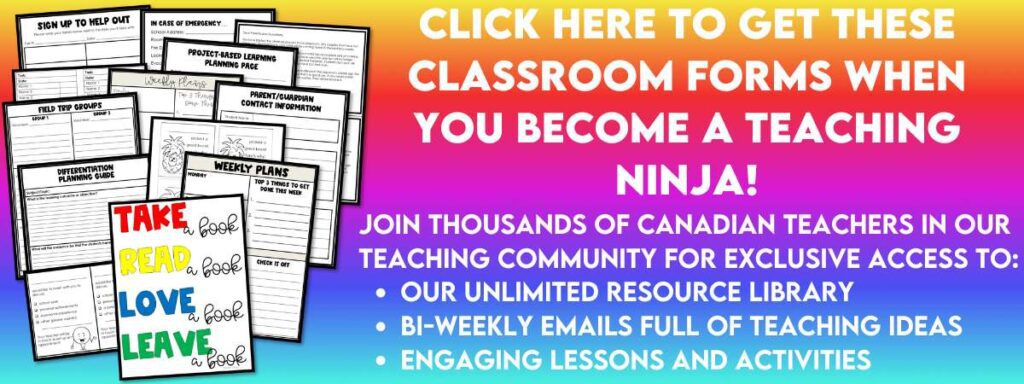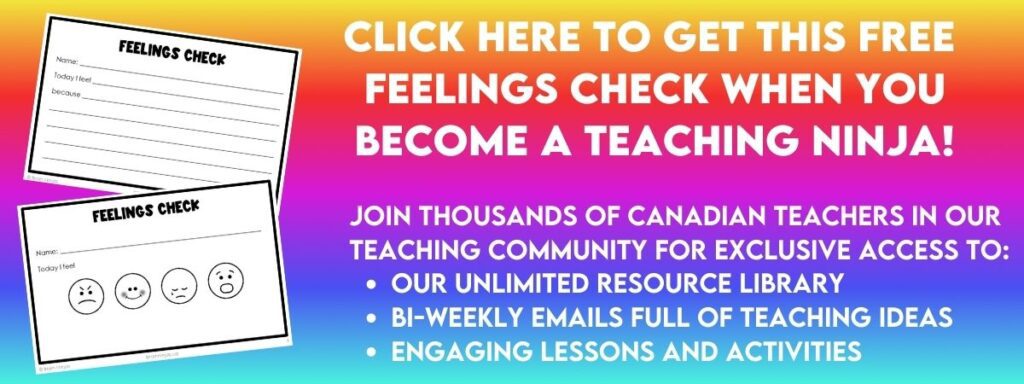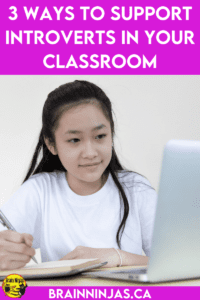
Despite what some people might know about me, I’m an introvert and as a student, being painfully shy made learning difficult. As a teacher, it’s made me acutely aware that it’s important to support introverts in the classroom. We need to advocate for their needs. Check out some of the ways we support introverts in the classroom.
What Are Extroverts and Introverts?
First, we teach students about the meaning of extroverts and introverts. Most importantly, we explain that people can be both types of people (we call them ambiverts) based on the situation and their own personal experiences. Generally, extroverts gather energy by being around people, chatting and hanging out with friends. Introverts gather energy by being alone. Ambiverts like a balance between spending time alone and with people.
We ask students to think about their preferences for the amount of noise they can handle. They are also asked to respect that their friends might have different preferences.
It is important to point out that being an introvert and being a shy person is not connected. An introvert can love performing, reading aloud in class or public speaking. While being an extrovert does not mean the person loves performing in public. Extroverts and introverts should be given the same opportunities to perform (or not perform) in front of others based on their comfort level.
Declare Extrovert and Introvert Time
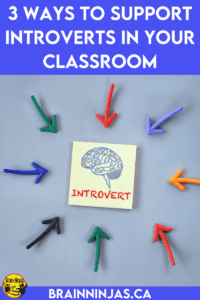
Explaining the differences and that people can be more than one type of personality. Give quiet time and noisy work times so everyone gets what they need for learning.
When planning for projects or activities, think about how students can choose between working in a group or working alone. Why does it need (or not need) to be a group work situation? If it doesn’t need to be a group situation, allow for independent workers to work alone on tasks.
Explicitly teach students the difference between extrovert time (where students can meet with each other and talk) and introvert time (where everyone works alone quietly). Practice working in each type of noise and interaction level until students truly understand the difference. Both extroverts and introverts benefit from both types of work situations. We call this time alone time and friend time.
Create Alternative Ways to Communicate Needs for Introverts in the Classroom
Whether your students are introverts, extroverts or somewhere in between, they should talk about their preferences for demonstrating their learning or communicating their needs. There are many ways students can do this based on whether they are introverts or extroverts. Some students are shy or quiet. Others don’t mind sharing in front of others.
Surveys
Survey your students to see what they need on a regular basis. They might not even know what they need, so offer suggestions. We use these learner profiles to survey our students at the beginning of the year. Occasionally, we’ll use the surveys or questions from them randomly throughout the school year.
We use these Learner Profiles as a starting point. If you’re looking for more ways to get to know your students try this post Getting to Know Your Students.
If your students have access to email, it can be a great way for a student to communicate their needs in a less public way. We encourage students to use email to report things like bullying, request times for a meeting or let us know about a private issue (like friend drama) they need advice about. Since it’s email, it is easy to include parents in the conversation (with student permission of course) by teaching students to carbon copy (cc) the email to their parents when it is appropriate.
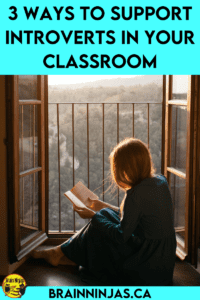
Notes
We leave a stack of notepads in a basket near our desk. Students know they have permission to use these notes to send us a message. Most of the time, students use them to draw cute pictures or say hello, but occasionally students will use them to anonymously report something or request a meeting.
Another way we use notes is to let students keep a notepad at their desks. When we’re taking questions about a topic, introverts can write their questions down and pass them to us. We’ll answer the questions without drawing attention to who has asked the question. This applies to answering questions as well. Students don’t need to share their answers publicly. They write them down and as we circle the room, they show us their answers so we can check for understanding.
Appointments
We use appointments to meet with students who want uninterrupted time to discuss an issue. Students use our appointment card sheets to request a time and we book them in during a break or before or after school.
Appointments can be a great way for introverts in the classroom to have a conversation without an audience. It is one of the most effective ways we’ve found to get to know these students. All students benefit from quality time and relationship building.
You can get our appointment cards for free. They can be found in our Resource Library, along with many other general classroom forms to help you organize your classroom, or we’ll send them straight to your inbox when you sign up for our email list.
Allow Recharging Times for Introverts in the Classroom
Sometimes to keep your introverts ready to learn, they need a few minutes to recharge. This can look different for different students.
Create Opportunities
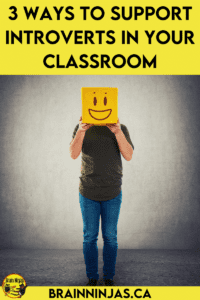
Some students just need a few minutes for themselves. These are often the students who take a long trip to the washroom. We let them. When we have established trust with a student, we’ll let them take a little walk around the school for some alone time. Sometimes we’ll intentionally choose them to run a short errand or give them a fake task (like going to look out the window to see if there are any classes at the playground). They just need a few moments to breathe and when the classroom is a wild and noisy place, leaving the classroom is a good option.
While we love our students to run around and burn off some energy during recess, our introverts in the classroom sometimes need to use this time to recharge. Occasionally, we’ll allow these students to stay in the classroom (when we already have to be there) to have quiet time. Our school actually holds a quiet club during the winter (you know those weeks on end where there are no outdoor recesses because it is too cold). Students can colour, read, set their heads down, meditate, or work on something they enjoy (one student knitted a scarf) as long as it is quiet.
Create Spaces
We’ve created some quiet, private spaces in our classroom. These spaces only have one seat (so they are not the place to gather for conversations). We are also very fortunate to have a closet in our classroom. Inside is a comfy chair. Students can ask to work there, but since there’s only room for one chair, it’s a space for one. Since it has a door, it is a little quieter than the rest of the room.
If you don’t have an alternative space for students, think about getting some noise-cancelling headphones. They work great for creating a quiet space and students can use them anywhere in the classroom. We have five sets in our room and they are almost always on someone’s head during work time. We’ve taught students that when someone is wearing the headphones, they do not want to be disturbed.
Use a System
In our classroom, we have a system called “Red Cups.” We grabbed a few of those red solo cups and leave them at the front of the classroom. Students are allowed to take a cup and leave it upside down on their desks. This is an indicator they are having some alone time. Everyone else can see that the student would just like a little alone time. Many students use these during lunch. They prefer to read a book quietly while eating.
A few years ago we had a principal who asked us to stop using the red cups because he believed students should be using their lunch to socialize. I had to actually bring him papers written by child psychologists to prove that some students don’t need to socialize and should be allowed to choose. Most of the introverts used the cups for part of the time, only some of the days or just once and a while. It didn’t mean they weren’t socializing or developing their social skills. In fact, in my experience, introverts are better at building friendships because they choose friends with less drama.
Use Brain Breaks for Introverts in the Classroom
Brain Breaks are to allow students to get a bit of movement in. They do not need to be loud dance parties (though that can be fun, too). Calming practices like breathing exercises or meditation can be beneficial to all your students.
Create a Safe Space for Participation

How to Make Mistakes
Students need to be taught how to be respectful of each other in group situations. This takes a lot of work starting on the first day of school. Teach students how they should respond when someone makes a mistake. Role-play different situations. Talk about how it feels when you’re the one who makes the mistake. Teach students how to recover from embarrassment.
We teach our students how to manage their feelings in this health unit called Managing Feelings. We have more ideas in our post How to Teach Students to Self-Regulate. At the beginning of the year, we go through the classroom expectations and during that time we go through the expected behaviours for how to treat each other. Year after year, we find so many students need direct teaching on how to be kind and respectful. All of these lessons are included in our health unit called Expected Vs. Unexpected Behaviours.
Build a Classroom Community
While it’s important for you to build relationships with the introverts in the classroom, it is also important that your students build relationships with each other. We use several activities from our Classroom Community unit to help teach our students to work together, trust each other, and work respectfully together. When things hit bumps in the roads during the school year, we’ll often revisit the activities.
Check Everyone Regularly
Put it in your plan book to check in with students on a regular basis. While we sometimes use appointment cards, when the novelty wears off, we often have to be more proactive.
One way we do this is with feelings checks. This simple activity has students write down their feelings and why they are experiencing this feeling. It’s part of the Managing Feelings unit, but anyone can do it. We always have the slips ready to go and will drop them on students’ desks to fill out after a break or will hand them out as they come in the door.
You can grab the feelings checks in our Resource Library. We can send them directly to your inbox when you sign up for our email list.
Give Permission to Pass
Sometimes classroom discussions cause anxiety for introverts because they need a little more time to process their ideas and get ready to share. If they are feeling especially drained, it can be hard to participate. We give all of our students permission to pass. Depending on the activity, that might be a permanent pass where we won’t ask them a question again. Other times, it’s a temporary pass when we explain that we’ll be back (in a certain length of time) to get their answer.
Introverts are People, Too
Often in society, the loudest voices are the only ones heard, but introverts always have something worthwhile to hear. It is our job as teachers to bring out the best in all of our students.
Typically, we’re drawn to the students who are most like us, so it is even more crucial to watch for those introverts if you are an extrovert. Introverts can sometimes feel like their drowning slowly in crowds and busy classrooms. Hand them a lifeline in their classroom
Do you have other ways you support introverts in your classroom? We’d love to hear your ideas. Drop us a comment below.

